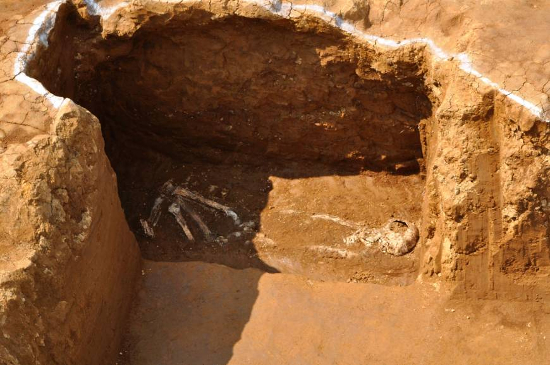 This 2014 photo shows human bones unearthed in Tokyo, which researchers believe are of the
This 2014 photo shows human bones unearthed in Tokyo, which researchers believe are of the 18th-century Italian missionary Giovanni Battista Sidotti. | AFP-JIJI
In case you missed it: "Italian priest imprisoned in 18th century may have been influential in Japan’s development" (The Japan Times, June 7, 2016):
Disguised as a samurai in kimono and topknot, Italian missionary Giovanni Battista Sidotti stole ashore on a small Japanese island in 1708, daring to enter a land hostile to his Christian creed.[Hat tip to Christopher Blosser]
He was quickly captured by authorities, who saw the alien faith as a threat to national identity. He was thrown into a prison for Christians, where torture was routine.
More than 300 years later, researchers using DNA analysis have confirmed that remains unearthed at a Tokyo construction site almost certainly belong to Sidotti — and say they back up historical accounts of his treatment.
Historians say Sidotti helped shape Japan’s view of the Western world with his knowledge after he won over the nation’s leading scholar of the day. But he fell from grace after refusing to give up his faith and his final days and death have been shrouded in mystery.
Christian missionaries made aggressive inroads in Japan in the 16th and 17th centuries, gaining adherents among commoners and even powerful warlords.
But fears they were an advance guard for European colonialism spurred a brutal crackdown long before Sidotti arrived.
Three sets of bones were unearthed in July 2014 from land that now forms the parking lot of an upscale condominium complex that was once the site of the prison — the Kirishitan Yashiki, or Christian Mansion. Its only reminder today is a stone marker commemorating the spot.
National Museum of Nature and Science researchers near Tokyo carefully cleaned the bone fragments before piecing them together like human jigsaw puzzles in a painstaking process that took more than six months.
Kenichi Shinoda, the museum’s chief of anthropology, analyzed DNA from a tooth and concluded that one of them had the same genetic type as present day Italians.
Japanese historical records show that only two missionaries from Italy had been held at the site, Sidotti and Giuseppe Chiara.
The latter was the model for the main character of a Portuguese priest in Shusaku Endo’s novel “Silence,” which director Martin Scorsese is turning into a film.
As records show Chiara was cremated after his death at 84, the unearthed remains are almost certain to be of Sidotti, who was 47 when he died in 1714, researchers said.
While at the prison, Japanese Christians and foreign missionaries were tormented with demands they renounce the banned religion, and many did so under duress.
While they feared foreign religion, Japanese officials also craved Western knowledge and scientific insights that were harder to obtain under the official policy of national seclusion that started in 1639.
As part of his interrogations, Sidotti was questioned by Japan’s top Confucian scholar, who developed a deep respect for the Roman Catholic priest for his knowledge of geography, languages and global affairs, experts said.
The scholar, the renowned Hakuseki Arai, is said to have tried to help Sidotti but the priest was later sent to the dungeon amid allegations he baptized the Japanese couple tending to his daily needs.
The Italian died there, but it is not clear how, researchers said.
Historical accounts, including those written by Japanese scholar Kotonobu Mamiya about a century later, however, mention that Sidotti was accorded a certain respect and treated far better than other prisoners — even in death.
Researchers say that is backed up by evidence from the remains.
Kazuhiro Sakaue, senior researcher of anthropology at National Museum of Nature and Science, observes a
restored skull believed to be that of Italian missionary Giovanni Battista Sidotti, at a laboratory
in Tsukuba, Ibaraki Prefecture, in April. | AFP-JIJI
“His body was laid flat in a casket, a luxurious one as far as I can tell by the brackets,” said Akio Tanigawa, professor of archaeology at Tokyo’s Waseda University and lead researcher on the remains, referring to coffin pieces discovered with the bones.
“People did not bury human bodies like this,” Tanigawa stressed, suggesting Sidotti was likely given a burial “in the Christian way.”
He said that in 18th century Tokyo, then known as Edo, people were buried in a sitting up position in a small tub.
The two sets of bones unearthed next to Sidotti’s may be those of the Japanese couple, Chosuke and Haru, researchers said, as at least one was placed in a small tub.
The missionary had a great impact on Japan, Tanigawa stressed, citing books by Arai. An adviser to the rulers of the time, he penned a study of the Western world for which Sidotti is cited as a key source.
“The knowledge shared by Sidotti surely changed Japan’s view of the world,” he said.
Related: Amy Welborn, "Reading Silence for the first time" (Catholic World Report, December 14, 2016)

No comments:
Post a Comment